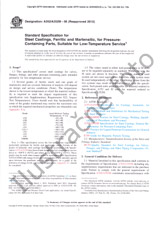Potrebujeme váš súhlas na využitie jednotlivých dát, aby sa vám okrem iného mohli ukazovať informácie týkajúce sa vašich záujmov. Súhlas udelíte kliknutím na tlačidlo „OK“.
ASTM C1656-13(2018)
Standard Guide for Measuring the Reactivity of Hydraulic Refractory Castables Using Exothermic Profile
NORMA vydaná dňa 1.10.2018
Informácie o norme:
Označenie normy: ASTM C1656-13(2018)
Poznámka: NEPLATNÁ
Dátum vydania normy: 1.10.2018
Kód tovaru: NS-900595
Počet strán: 3
Približná hmotnosť: 9 g (0.02 libier)
Krajina: Americká technická norma
Kategória: Technické normy ASTM
Kategórie - podobné normy:
Anotácia textu normy ASTM C1656-13(2018) :
Keywords:
castable, EP, exothermic profile, refractory, working time,, ICS Number Code 91.100.10 (Cement. Gypsum. Lime. Mortar)
Doplňujúce informácie
| Significance and Use | ||||||
|
4.1 The heat of hydration of a calcium aluminate-based castable is liberated over a short period of time (as compared to portland cement). This makes it easy to measure the heat profile using off-the-shelf thermocouple equipment. 4.2 The heat profile can be used to make inferences about the setting and strength gain behavior of a castable and sometimes the working time of a castable. 4.3 Factors that should be controlled when comparing two castables include: size, shape, and mass of cast object, start temperature of the mix, temperature of environment, and the thermal conductivity of the environment. If these factors are held constant, then the two castables’ heat profiles can be compared. 4.4 The temperature increase created by the castable exothermic reaction shall be at least 2.0 °C more than the normal fluctuation of the laboratory temperature so that the time of this increase is easily discernible to the user. 4.5 Varying the amount of cement in the castable, the amount of water, the type and quantity of admixtures, and so forth, will change the shape, maximum temperature, and time to maximum temperature of the curve. 4.6 Following is an example of a curve generated for an LCC (see Fig. 1) that does exhibit two peaks, the first one marking the end of working time. In this curve, one could also infer that the start temperature of the mix was 24 °C and also that the hydraulic strength gain reaction was significantly started, but not completed by 6 h. FIG. 1 Example of LCC Exo Profile |
||||||
| 1. Scope | ||||||
|
1.1 This guide applies to all castables with a reactive binder system that produces a measurable heat profile during the setting and hardening process. The majority of these systems will have calcium aluminate cement as one component of the binder system. 1.2 This standard does not purport to address all of the safety concerns, if any, associated with its use. It is the responsibility of the user of this standard to establish appropriate safety, health, and environmental practices and determine the applicability of regulatory limitations prior to use. 1.3 This international standard was developed in accordance with internationally recognized principles on standardization established in the Decision on Principles for the Development of International Standards, Guides and Recommendations issued by the World Trade Organization Technical Barriers to Trade (TBT) Committee. |
||||||
| 2. Referenced Documents | ||||||
|




 Cookies
Cookies
